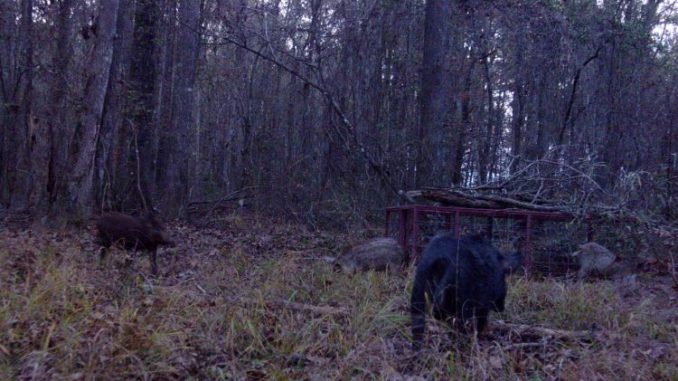
You don’t have to break the bank to put a hurtin’ on some wild pigs
We’ve talked about hunting feral hogs to thin the herd. I don’t know about you, but I’m not much on summer hunting. The sweat tends to rust my rifle. So when the thermometer reaches into the 90s, I think it’s time to trap hogs. Summer is a good time for hog trapping for a few other reasons, as well.
Sows will have produced litters of pigs in late-winter and early-spring. The pigs are weaned by now and are busy doing pig things like breeding, rooting up the world, breeding and competing with deer and other wildlife for food. Did I mention breeding? But the youngsters are not as experienced and wary as adult hogs, and are easier to trap now.
Mid- to late-summer can also be a lean time for hogs. During summer’s dog days, soft mast such as berries are gone, along with clover and lush spring grasses. Summer sun with little rain can turn the ground to stone, making rooting for roots, worms and grubs very difficult. Food is scarce, and hogs will more readily enter traps baited with corn or other feed.
Choosing the right trap
So what’s the best hog trap? Nowadays a wide selection of good traps are on the market and are being used effectively. They range in price from thousands for high-tech designs, down to a few bucks for some hog panel or fence wire and steel posts. I have seen all work well, and not so well.
But before investing thousands in the latest and greatest model, try some low-tech designs. Case in point: Members of a hunting lease had lots of hogs on the property and wanted them gone. They invested more than $7,000 in a big trap with battery powered cameras and cell phone-operated remote controls. It looked impressive. Then I heard they were having trouble with the cell phone signal and weren’t catching any hogs. I hope they got things worked out, but don’t know for sure. I do know that years before, former members of that lease used old-fashioned corral and cage traps with good success on hogs — no batteries required.
That certainly does not mean the newest designs don’t work. I have a friend winning his hog war with one of the advanced technology traps. He has taken more than 70 hogs off his lease in the last six months. But those of us on more limited budgets can catch hogs, too. The key is in learning where and how to place traps.
Choosing the right spot
Hogs are nomads and move with the seasons as different food sources become available. In fall and winter, they go to hardwoods for acorns, pecans and other mast. In spring, it’s clover and ripening berries. Summer will find them near agricultural crops or any other forage they can find. Even more important in summer is water. Hogs can’t take much heat, so they will seek out water for drinking and wallowing in the cool mud. This makes them somewhat predictable, and they will usually be found in the same areas at the same time each year.
Bedding areas are even more reliable. If an area has the right combination of cover, nearby water and reasonable proximity to a food source, hogs will use the same bedding spot consistently.
In summer, place traps near bedding areas along trails to and from feeding grounds. If hogs are grazing pastures or summer wildlife food plots, place traps along the edges — preferably where trails from bedding areas enter the open ground.
A land manager friend has been trapping hogs on his employer’s property for many years. He uses corral and cage traps in locations described above. Those traps are rarely moved, and continue to catch hogs year after year. Portable cage traps are a great option for quick set-up at hotspots where fresh hog sign is found, or if the trapper only has one or two traps and needs to hit several locations.
Bait and wait…patiently
Never bait and set a trap immediately. Hogs are smart and suspicious, and will be very hesitant to enter the trap at first. Scatter corn around the outside of the trap as well as inside. Tie the door open and allow them to feed in and out of the trap unharmed for a few days. Gradually put less feed outside and more inside. Use a game camera to monitor progress. Once hogs are comfortable going in the trap, set it and catch them.
A basic hunting license is required for trapping hogs with corral or cage traps, and traps must have an opening in the top measuring at least 22 X 22 inches, or 25 inches in diameter. So get the hogs now — before they compete with wildlife for mast this fall.


